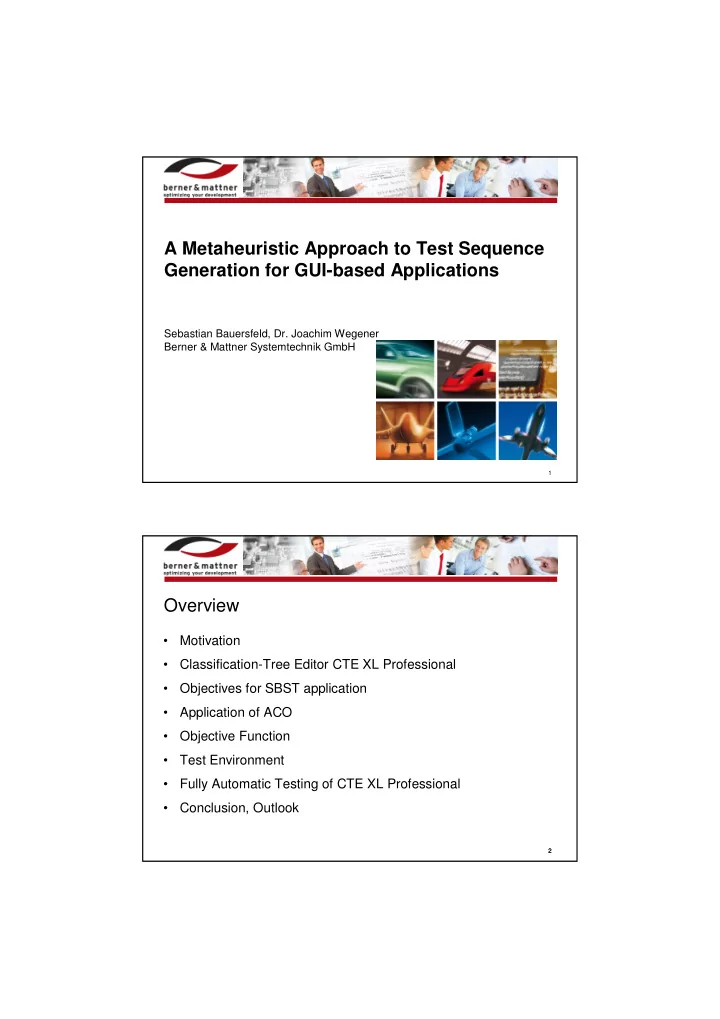

A Metaheuristic Approach to Test Sequence Generation for GUI-based Applications Sebastian Bauersfeld, Dr. Joachim Wegener Berner & Mattner Systemtechnik GmbH 1 Overview • Motivation • Classification-Tree Editor CTE XL Professional • Objectives for SBST application • Application of ACO • Objective Function • Test Environment • Fully Automatic Testing of CTE XL Professional • Conclusion, Outlook 2
Motivation • Many GUI based applications in all application domains • Tester’s task to define, execute and evaluate most interesting input sequences • Input sequences are sequences of user actions (mouse events, keyboard events etc. such as clicks, drag and drop, keystrokes) • Existing tools: – Many Capture + Replay Tools available, but limited applicability (e.g. B&M uses TestComplete and QF Test) • Definition of test sequences – by capturing user actions – developing test scripts • Only replay part is “automatic” � Test suites require constant maintenance � Labor intensive � Automatic generation of input sequences is quite desirable 3 Typical Berner & Mattner Products CTE XL Prof. MESSINA MERAN Variant management and Systematic test case design for Virtual Integration and model-based development specification-based testing Testing of AUTOSAR-SWC for specifications in DOORS Java applications based on Eclipse RCP and SWT 4
CTE XL Prof. Drawing area for classification trees Combination table for test case specifications Panel for establishing RM connections 5 Objectives for Application of Search-Based Testing • search for interesting test sequences • fullest possible execution of the program functions in different contexts • in our case: – find sequences that generate large amounts of different call stacks ( the more CSs a sequence generates, the more aspects of the SUT are tested (McMaster et al.) ⇒ call trees with many leaves most interesting for fault detection) – check for exceptions occurring during the execution • Alternatively: – Check for memory leaks, – Check for code coverage, – Check for performance bottlenecks, – Check for assertion violations – … 6
Application of Ant Colony Optimization Reasons for using ACO • ACO usually applied for sequence generation problems, e.g. TSP. Independent of mutation and crossover. • Mutation operator problems for sequence generation – Easy generation of infeasible sequences (not all actions are available in all contexts) – Neighbourhood of a sequence leads to artificial definitions • Crossover operators introduce similar problems (exchanging sequence parts will lead to infeasible sequences) 7 7 Ant Colony Optimization • Idea: – C = component set (here: C = set of feasible actions) – Generate trails (sequences of user actions) by selecting components considering pheromone values p i c i ∈ C • Pseudo random proportionate selection – Assess trails (# Call Tree Leaves) – Reward components c i that appear in “good” trails by increasing their pheromones p i • After each generation – Only top k trails are considered p ' p ( 1 α ) r – where is the evaporation / = ⋅ − + α ⋅ α i i i learning rate and r i the average reward of the trails that c i appeared in 8
Objective Function For each generated sequence of user actions the size of its call tree is calculated by the number of leaves: # CT leaves. Call Trees for multiple threads are combined into one call tree. Redundancies are eliminated. 9 Test Environment 0 n+1 n t t+1 TCP/IP 10 10
Test Environment Optimization Component Java Agent • implements the search (ACO) • independent of source code • maintains the pheromones for • attaches to SUT each named action according to • instruments bytecode to obtain call trees call tree (includes third party • selects most promising actions modules) • analyse exceptions • scans the GUI to create a widget tree for each execution state • defines unique identifiers for each action • executes selected actions • returns overall call tree • monitors exceptions 11 11 Test Environment – Sequence Generation Determine defined actions for widgets 12 12
Active Widget Tree 13 13 Active Widget Tree 14 14
15 15 16 16
Experiment ACO Run Random Run 17 17 Conclusion • High demand for automatic GUI testing in industrial practice • Typical application: CTE XL Professional (Eclipse RCP, SWT) • Functional testing for logical errors difficult, because guidance to unknown logical errors hard to formalize • Functional testing for exceptions, memory leaks, … possible • Test environment allows to – determine all possible user actions in each execution state – selects most interesting actions – assesses overall quality of test sequences by analyzing the call tree – generates long test sequences with most highest variety • Evaluation – Application of search successfull – Initial experiments confirm better performance than random testing 18 18
Outlook • Experiments on generating entire test suites to be performed • Possible improvement of algorithm to be more explorative • Evaluate more advanced objective functions (not only number of call tree leaves) • Increase efficiency – Sequence generation is expensive � parallelization of search and test – ACO good choice? � disregards linkage among actions (context of actions not considered for pheromone value calculation) Fault sensitivity of generated sequences � empirical evaluation • 19 19
Recommend
More recommend